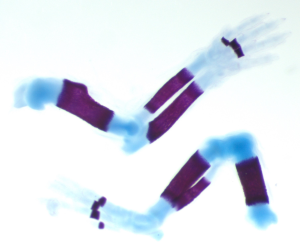Pioneering new strategy lengthens limbs to treat skeletal disorder
Posted by Alex Eve, on 15 February 2023
A Press Release from Development
Robinow Syndrome is the best known of a set of genetic disorders that affect the growth and development of the skeletal system. Patients with these conditions have facial abnormalities, such as cleft palate, and develop short-limb dwarfism by around 18 months. Now, in a study published in Development, scientists from Nationwide Children’s Hospital in Ohio, USA, and the Van Andel Research Institute in Michigan, USA have shown the first successful correction of limb length in a mouse model of a very similar disorder known as FZD2-associated autosomal dominant Robinow Syndrome, providing hope for future therapies.

Although autosomal dominant Robinow Syndrome disorders are extremely rare (affecting around 50 families worldwide), they’re associated with genetic variations (mutations) in a group of genes that can be inherited from one parent or arise spontaneously, meaning diagnosis is not always trivial. Professor Rolf Stottmann who led the study said, “we began the project by studying the genomes of families with structural birth differences of the brain and face who had not yet received a genetic diagnosis. We identified that one of the initial families in this cohort had a mutation in the FZD2 gene.”
FZD2 is now known to be one of the known genes linked to autosomal dominant Robinow Syndrome. Like the other genes in this group, FZD2 makes a protein involved in sending signals that cells use to organise themselves into tissues. In their study, Professor Stottmann and colleagues used CRISPR/Cas9 genome-editing technology to induce mutations in a precise region of Fzd2, reproducing the specific types of mutations found in human patients. The researchers found that mice with these mutations had facial and skeletal malformations resembling those seen in the patients, including cleft palates and limbs less than half the normal size.
The researchers predicted that these types of Fzd2 mutations would disrupt signalling and hinder skeletal growth. To rescue the missing signals, the scientists intervened by treating pregnant mice with a drug that stimulates the signalling pathway. “This drug is an attractive option because we think we know how it works and previous work had shown that it could rescue cleft palates in a mouse model,” Professor Stottmann explained. Strikingly, they found that the pups exposed to the drug had significantly longer limbs than the untreated model mice.
The success of these experiments in mice suggests the drug could also be used as a therapeutic treatment in human patients. “The idea of treating the limb bones medically rather than surgically is a really important proof of principle, which we demonstrate in this study,” said Professor Stottmann, “we are very excited to test if this could work in the context of other genes associated with autosomal dominant Robinow Syndrome.”
Liegel, R.P., Michalski, M.N., Vaidya, S., Bitterman, E., Finnerty, E., Menke, C.A., Diegel, C.R., Zhong, Z.A., Williams, B.O., Stottmann, R.W. (2023). Successful therapeutic intervention in novel mouse models of Frizzled 2-associated congenital malformations. Development, 150, dev201038. doi:10.1242/dev.201038


 (No Ratings Yet)
(No Ratings Yet)